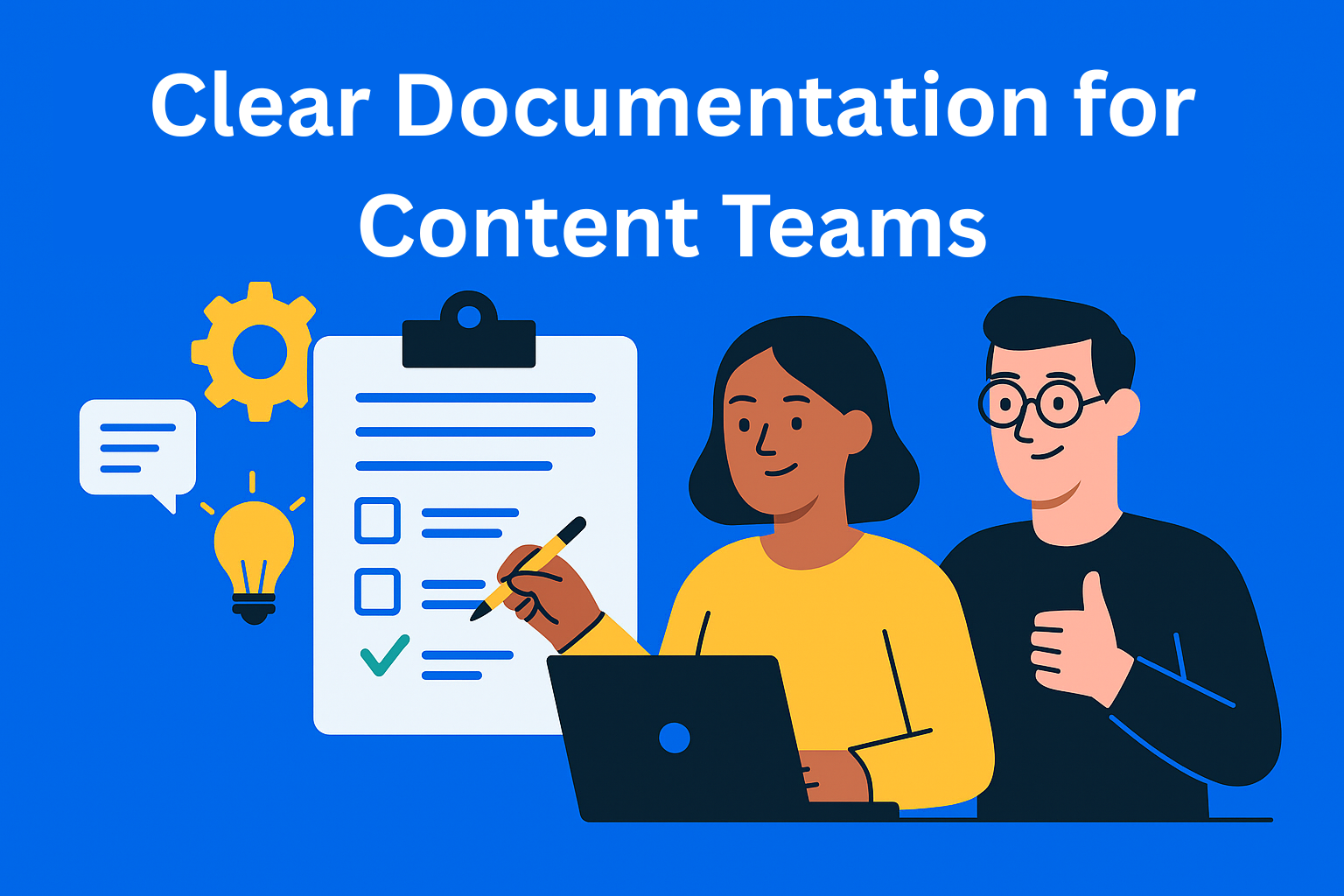Why Every Content Team Needs Clear Documentation
Great content doesn’t happen by accident, it’s built on clear documentation. It helps your team stay aligned, move faster, and stay consistent - even as it grows. Learn what to document and how to keep your content sharp and on-brand.

Great content doesn’t just happen - it’s built on clear systems, shared standards, and people who know what “good” looks like.
Today's content teams are busy. They juggle multiple projects, work with AI tools, and collaborate across time zones. So, having solid documentation can be a lifesaver.
Whether you’re creating landing pages, blog posts, or product copy, clear documentation helps your team stay aligned, move faster, and maintain quality - even when the team grows or changes.
In this post, we’ll cover why documentation matters, what your team should document, and how to build content guidelines that are actually useful.
Key Takeaways
- Documentation ensures consistency and clarity - It removes guesswork, aligns tone and structure, and keeps everyone on the same page.
- Voice and tone guides are foundational - Define personality traits, provide examples, and include do/don’t lists to guide both humans and AI.
- Prompt libraries improve AI output - Pre-built prompts help generate more aligned drafts and reduce generic or off-brand results.
- Templates and structure speed up content creation - Writers work faster (and better) with predefined formats, sections, and expectations.
- Good documentation becomes part of the workflow - When guidelines live inside briefs, templates, and review steps, they actually get used.
Why Documentation Is So Critical for Content Teams
If your team writes everything from scratch every time, if your tone changes between pieces, or if you’re constantly answering the same “how should this sound?” questions, you need documentation.
Especially today, where AI is often part of the workflow, clear documentation serves as the foundation your writers (and AI tools) can build on.
Here’s what strong documentation helps you do:
- Stay consistent across formats and channels
- Train new writers or freelancers quickly
- Reduce editing time and revisions
- Make AI output more aligned with your brand voice
- Free up your brain from repetitive decisions
It’s not about control - it’s about clarity.
The more you document, the less guesswork your team has to do and the more energy they can put into actually creating great content.
What Should Be in Your Content Documentation?
Content documentation can (and should) evolve with your team. But there are a few core areas every team should cover to keep things running smoothly.
1. Voice and Tone Guidelines
This is where you define how your brand sounds and, more importantly, how your content should feel.
Your voice is consistent across everything. Your tone shifts depending on the context.
What to include:
- 3-4 personality traits (e.g., “Confident but approachable”)
- Examples of what that looks like in action
- A breakdown of how tone shifts across formats (blog vs. support article vs. email)
- A “do/don’t” list to make things clearer
Example:
Voice trait: Direct
Do: Use short sentences, active voice, and eliminate filler
Don’t: Ramble, hedge, or use passive constructions
If your team uses AI for first drafts, this section becomes even more important. AI models won’t magically match your tone; you have to tell them what it is.
2. Prompt Libraries for AI-Generated Content
AI tools are helpful for speed, but without proper prompting, they often produce generic or off-brand content.
Creating a prompt library in your documentation gives writers a solid starting point when using tools like ChatGPT or Claude.
What to include:
- Prompts for common content types (blog posts, meta descriptions, product blurbs, FAQs)
- Prompts that include voice/tone direction
- Fields for target audience, goal, and structure
- Optional follow-up prompts to refine drafts
Example:
“Write a blog post outline for [topic] aimed at [audience]. Use a confident but friendly tone. Prioritize clarity and avoid corporate jargon.”
You can also include tips on editing AI content to make it sound more human - a quick checklist that lives in the doc can help ensure quality.
3. Content Structure Templates
Beyond how it sounds, your content also needs to look consistent.
Each content type should have a structure guide: what goes where, what’s optional, and what must be included.
What to include:
- Standard section breakdowns (e.g. intro, subheads, CTA, summary)
- Word count ranges
- Formatting preferences (bullets, quotes, visuals)
- Common internal links or CTAs
Example:
Product Page TemplateH1: Product nameSubhead: Key value propSection 1: What it doesSection 2: BenefitsSection 3: How it worksCTA button with action-oriented copy
The more structure you give your writers, the easier it is for them to deliver high-quality content faster, and for editors to review it efficiently.
4. SEO and Metadata Standards
This one gets overlooked, but it matters a lot, especially for teams producing high volumes of web content.
Define your standards once, and save yourself dozens of questions later.
What to include:
- Character limits for titles and meta descriptions
- Keyword usage best practices
- Heading structure rules (H1, H2, etc.)
- Internal linking guidelines
If you have different SEO requirements for different content types (e.g., product pages vs. blog posts), document those separately.
5. Review and Approval Guidelines
Knowing who does what at each step is just as important as knowing how the content should sound.
What to include:
- Roles and responsibilities for writing, editing, and approvals
- What reviewers should be looking for at each stage (voice, accuracy, tone, SEO, etc.)
- How feedback should be delivered (e.g., tracked changes, comments, checklist)
Having this clarity saves time, cuts down on feedback loops, and makes it easier for the whole team to collaborate.
How EasyContent Helps You Turn Guidelines Into Action
Creating documentation is only half the battle - the other half is getting people to use it.
That’s where EasyContent helps.
You can build your voice and tone documentation right into your workflow using custom templates. Writers see guidelines in context while they’re working - not hidden in a drive folder no one opens.
For example, you can:
- Create fields for tone, audience, SEO notes, or internal links
- Build checklists into templates to ensure brand standards are followed
- Share prompt libraries directly in content briefs
- Set up multi-step workflows so editors, reviewers, and other roles know exactly what to check at each stage
Everything lives in one place, which means your documentation isn’t just a reference; it becomes part of how the team works.
Tips for Making Your Documentation Useful
Documentation only helps if people use it, so keep it simple and practical.
- Make it skimmable - Use headers, examples, and short explanations
- Keep it updated - Review it quarterly or after major campaigns
- Refer to it often - During reviews, team meetings, or onboarding
- Tie it to your workflow - Put reminders and links in templates or briefs
- Get feedback - Ask your team what’s missing or unclear
The goal isn’t to create a perfect doc. It’s to create a useful one.
Final Thoughts
Clear documentation is one of the easiest ways to improve content quality without adding more layers of review or slowing your team down.
It gives writers direction, editors consistency, and AI tools a foundation to build on.
The more your team can rely on documented guidelines for tone, structure, prompts, or workflow, the less time you’ll spend correcting off-brand content, re-explaining your process, or digging through folders for reference examples.
So if content creation still feels a little chaotic, start here. Build the system once and let your team (and your content) do what it does best.






